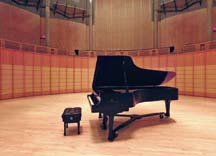Since opening in 1997, the Chan Centre for the Performing Arts in Vancouver, B.C., Canada, has earned an international reputation for its striking design and stellar acoustics.
It offers three performance spaces, led by the 1,200-seat Shun Concert Hall, which presents a diverse offering of performances, including classical recitals and jazz concerts, avant-garde theatre and opera productions, and folk and world music.
Recently, approval was granted to upgrade the facility’s stage monitoring capabilities, with the existing wedges deemed too cumbersome for most of the venue’s applications, in addition to drawing fire for lack of sonic quality and rider incompatibility.
Jay O’Keeffe, head sound technician for the centre, took the process to the limit, organizing a “shootout” of leading stage wedges, with eight manufacturers bringing 17 different models for evaluation on the Shun stage.
All participants were provided with specific testing protocols and performance expectations well in advance so there would be no surprises or complaints of unfairness. Both active and passive monitors were included, as were models with a variety of driver and horn sizes.
Every non-powered wedge was driven with Lab.gruppen PLM 10000Q amplifiers. Each unit was heard both un-processed, as well as with recommended factory presets, and level balancing of all monitors helped insure that the listening tests could be focused on frequency and depth of field rather than audible perception of power differentials..
There is no proscenium on the Shun Concert Hall stage, and the surfaces behind the performance area are designed to acoustically amplify and disperse sound into the audience area. With a 105 dB (A weighted) specification for the floor monitors, precisely controlled dispersion was very important, as was consistent performance at multiple heights, including standing, seated and floor level.
The Smaart test and measurement platform was deployed to capture data both on- and off-axis. FFT measurements were made for each unit, along with phase and magnitude response, sound pressure level, and sensitivity. “This was done in order to verify that the monitors responded ‘in situ’ in a manner similar to the published specifications of the manufacturers,” O’Keefe explains.
Smaart in tandem with the software for the PLM software for the amplifiers also allowed the Chan Centre techs to quickly contour each monitor’s sound to match the changing room tone on any given area on the stage. “The variable acoustics within the concert hall means that we can alter the room’s early reflections and reverb decay to best suit the music and because of that degree of variation we needed a monitor system that was as equally variable,” he says.
As per the established testing protocol, the AES standard A weighted shaped swept sine wave of 24 seconds duration as well as the AES standard Pink Noise were used as test stimuli, with the results measured and compared. “In most instances we had two examples of each model, which allowed us to verify results and quality control of the respective product lines,” he adds.





















